Tree Species Selection in the Face of Drought Risk—Uncertainty in Forest Planning
Abstract
:1. Introduction
2. Materials and Methods
2.1. Forest Data
2.2. Climate Scenarios
2.3. Soil Data
2.4. Rule-Set for Stand Type Planning
2.5. Adaptation Effort
3. Results
3.1. Stand Type Planning under Constant Site Conditions
3.2. Adaptive Stand Type Planning under Drought Restrictions
4. Discussion
4.1. Tree Species Selection in Light of Changing Environmental Conditions
4.2. Drought Vulnerability Assessment in Forest Planning
4.3. Climate Uncertainty in the Context of Forest Conversion
4.4. The Findings and Their Implications in a Broader Context
5. Conclusions
Supplementary Materials
Acknowledgments
Author Contributions
Conflicts of Interest
References
- Smith, S.J.; Edmonds, J.; Hartin, C.A.; Mundra, A.; Calvin, K. Near-term acceleration in the rate of temperature change. Nat. Clim. Chang. 2015, 5, 333–336. [Google Scholar] [CrossRef]
- Ballester, J.; Rodó, X.; Giorgi, F. Future changes in Central Europe heat waves expected to mostly follow summer mean warming. Clim. Dyn. 2010, 35, 1191–1205. [Google Scholar] [CrossRef]
- Beniston, M.; Stephenson, D.B.; Christensen, O.B.; Ferro, C.A.T.; Frei, C.; Goyette, S.; Halsnaes, K.; Holt, T.; Jylhä, K.; Koffi, B.; et al. Future extreme events in European climate: An exploration of regional climate model projections. Clim. Chang. 2007, 81, 71–95. [Google Scholar] [CrossRef]
- Christensen, J.H.; Hewitson, B.; Busuioc, A.; Chen, A.; Gao, X.; Held, R.; Jones, R.; Kolli, R.K.; Kwon, W.; Laprise, R.; et al. Regional climate projections. In Climate Change, 2007: The Physical Science Basis; Contribution of Working Group I to the Fourth Assessment Report of theIntergovernmental Panel on Climate Change; Solomon, S., Qin, D., Manning, M., Chen, Z., Marquis, M., Averyt, K., Tignor, M., Miller, H., Eds.; Cambridge University Press: Cambridge, UK; New York, NY, USA, 2007; pp. 847–940. [Google Scholar]
- Neumann, M.; Mues, V.; Moreno, A.; Hasenauer, H.; Seidl, R. Climate variability drives recent tree mortality in Europe. Glob. Chang. Biol. 2017. [Google Scholar] [CrossRef] [PubMed]
- Boisvenue, C.; Running, S.W. Impacts of climate change on natural forest productivity—Evidence since the middle of the 20th century. Glob. Chang. Biol. 2006, 12, 862–882. [Google Scholar] [CrossRef]
- Pretzsch, H.; Biber, P.; Schütze, G.; Uhl, E.; Rötzer, T. Forest stand growth dynamics in Central Europe have accelerated since 1870. Nat. Commun. 2014, 5, 4967. [Google Scholar] [CrossRef] [PubMed]
- Lindner, M.; Maroschek, M.; Netherer, S.; Kremer, A.; Barbati, A.; Garcia-Gonzalo, J.; Seidl, R.; Delzon, S.; Corona, P.; Kolström, M.; et al. Climate change impacts, adaptive capacity, and vulnerability of European forest ecosystems. For. Ecol. Manag. 2010, 259, 698–709. [Google Scholar] [CrossRef]
- Hanewinkel, M.; Hummel, S.; Cullmann, D.A. Modelling and economic evaluation of forest biome shifts under climate change in Southwest Germany. For. Ecol. Manage. 2010, 259, 710–719. [Google Scholar] [CrossRef]
- Zubizarreta-Gerendiain, A.; Garcia-Gonzalo, J.; Strandman, H.; Jylha, K.; Peltola, H. Regional effects of alternative climate change and management scenarios on timber production, economic profitability and carbon stocks in Norway spruce forests in Finland. Can. J. For. Res. 2015, 283, 274–283. [Google Scholar] [CrossRef]
- Hanewinkel, M.; Cullmann, D.A.; Schelhaas, M.; Nabuurs, G.; Zimmermann, N.E. Climate change may cause severe loss in the economic value of European forest land. Nat. Clim. Chang. 2012, 3, 203–207. [Google Scholar] [CrossRef]
- Thiele, J.C.; Nuske, R.S.; Ahrends, B.; Panferov, O.; Albert, M.; Staupendahl, K.; Junghans, U.; Jansen, M.; Saborowski, J. Climate change impact assessment—A simulation experiment with Norway spruce for a forest district in Central Europe. Ecol. Model. 2017, 346, 30–47. [Google Scholar] [CrossRef]
- Schelhaas, M.J.; Nabuurs, G.J.; Hengeveld, G.; Reyer, C.; Hanewinkel, M.; Zimmermann, N.E.; Cullmann, D. Alternative forest management strategies to account for climate change-induced productivity and species suitability changes in Europe. Reg. Environ. Chang. 2015, 15, 1581–1594. [Google Scholar] [CrossRef]
- Brang, P.; Bugmann, H.; Bürgi, A.; Mühlethaler, U.; Rigling, A.; Schwitter, R. Klimawandel als waldbauliche Herausforderung. Schweiz. Z. Forstwes. 2008, 159, 362–373. [Google Scholar] [CrossRef]
- Foley, A.M. Uncertainty in regional climate modelling: A review. Prog. Phys. Geogr. 2010, 34, 647–670. [Google Scholar] [CrossRef]
- Knutti, R.; Sedlácek, J. Robustness and uncertainties in the new CMIP5 climate model projections. Nat. Clim. Chang. 2013, 3, 369–373. [Google Scholar] [CrossRef]
- Baumberger, C.; Knutti, R.; Hirsch Hadorn, G. Building confidence in climate model projections: An analysis of inferences from fit. Wiley Interdiscip. Rev. Clim. Chang. 2017, 8, e454. [Google Scholar] [CrossRef]
- Kandlikar, M.; Risbey, J.; Dessai, S. Representing and communicating deep uncertainty in climate-change assessments. C. R. Geosci. 2005, 337, 443–455. [Google Scholar] [CrossRef]
- Singh, R.; Reed, P.M.; Keller, K. Many-objective robust decision making for managing an ecosystem with a deeply uncertain threshold response. Ecol. Soc. 2015, 20, 12. [Google Scholar] [CrossRef]
- Lempert, R.J.; Collins, M.T. Managing the Risk of Uncertain Threshold Responses: Comparison of Robust, Optimum, and Precautionary Approaches. Risk Anal. 2007, 27, 1009–1026. [Google Scholar] [CrossRef] [PubMed]
- Yousefpour, R.; Augustynczik, A.L.D.; Hanewinkel, M. Pertinence of reactive, active, and robust adaptation strategies in forest management under climate change. Ann. For. Sci. 2017, 1–10. [Google Scholar] [CrossRef]
- Dessai, S.; Hulme, M. Assessing the robustness of adaptation decisions to climate change uncertainties: A case study on water resources management in the East of England. Glob. Environ. Chang. 2007, 17, 59–72. [Google Scholar] [CrossRef]
- United Nations Department of Humanitarian Affairs. Internationally Agreed Glossary of Basic Terms Related to Desaster Management. Available online: http://reliefweb.int/sites/reliefweb.int/files/resources/004DFD3E15B69A67C1256C4C006225C2-dha-glossary-1992.pdf (accessed on 11 May 2017).
- Van Heerden, K.; Yanai, R.D. Effects of stresses on forest growth in models applied to the Solling spruce site. Ecol. Model. 1995, 83, 273–282. [Google Scholar] [CrossRef]
- Hanson, P.J.; Weltzin, J.F. Drought disturbance from climate change: Response of United States forests. Sci. Total Environ. 2000, 262, 205–220. [Google Scholar] [CrossRef]
- Allen, C.D.; Macalady, A.K.; Chenchouni, H.; Bachelet, D.; McDowell, N.G.; Vennetier, M.; Kitzberger, T.; Rigling, A.; Breshears, D.D.; Hogg, E.H.T.; et al. A global overview of drought and heat induced tree mortality reveals emerging climate change risk for forests. For. Ecol. Manag. 2010, 259, 660–684. [Google Scholar] [CrossRef]
- Birdsey, R.; Pan, Y. Drought and dead trees. Nat. Clim. Chang. 2011, 1, 444–445. [Google Scholar] [CrossRef]
- Spellmann, H.; Albert, M.; Schmidt, M.; Sutmöller, J.; Overbeck, M. Waldbauliche Anpassungsstrategien für veränderte Klimaverhältnisse. AFZ-Derwald 2011, 66, 19–23. [Google Scholar]
- Spathelf, P.; Van Der Maaten, E.; Van Der Maaten-Theunissen, M.; Campioli, M.; Dobrowolska, D. Climate change impacts in European forests: The expert views of local observers. Ann. For. Sci. 2014, 71, 131–137. [Google Scholar] [CrossRef]
- Choat, B.; Jansen, S.; Brodribb, T.J.; Cochard, H.; Delzon, S.; Bhaskar, R.; Bucci, S.J.; Feild, T.S.; Gleason, S.M.; Hacke, U.G.; et al. Global convergence in the vulnerability of forests to drought. Nature 2012, 491, 752–756. [Google Scholar] [CrossRef] [PubMed]
- Anderegg, L.D.L.; Anderegg, W.R.L.; Berry, J.A. Not all droughts are created equal: Translating meteorological drought into woody plant mortality. Tree Physiol. 2013, 33, 701–712. [Google Scholar] [CrossRef] [PubMed]
- Adger, W.N. Vulnerability. Glob. Environ. Chang. 2006, 16, 268–281. [Google Scholar] [CrossRef]
- Moss, R.H.; Edmonds, J.A.; Hibbard, K.A.; Manning, M.R.; Rose, S.K.; Van Vuuren, D.P.; Carter, T.R.; Emori, S.; Kainuma, M.; Kram, T.; et al. The next generation of scenarios for climate change research and assessment. Nature 2010, 463, 747–756. [Google Scholar] [CrossRef] [PubMed]
- Van Vuuren, D.P.; Edmonds, J.; Kainuma, M.; Riahi, K.; Thomson, A.; Hibbard, K.; Hurtt, G.C.; Kram, T.; Krey, V.; Lamarque, J.-F.; et al. The representative concentration pathways: An overview. Clim. Chang. 2011, 109, 5. [Google Scholar] [CrossRef]
- Orlowsky, B.; Gerstengarbe, F.W.; Werner, P.C. A resampling scheme for regional climate simulations and its performance compared to a dynamical RCM. Theor. Appl. Climatol. 2008, 92, 209–223. [Google Scholar] [CrossRef]
- Volodin, E.M.; Dianskii, N.A.; Gusev, A.V. Simulating present-day climate with the INMCM4.0 coupled model of the atmospheric and oceanic general circulations. Atmos. Ocean. Phys. 2010, 46, 414–431. [Google Scholar] [CrossRef]
- Stevens, B.; Giorgetta, M.; Esch, M.; Mauritsen, T.; Crueger, T.; Rast, S.; Salzmann, M.; Schmidt, H.; Bader, J.; Block, K.; et al. Atmospheric component of the MPI-M earth system model: ECHAM6. J. Adv. Model. Earth Syst. 2013, 5, 146–172. [Google Scholar] [CrossRef]
- Bi, D.; Dix, M.; Marsland, S.J.; O’Farrell, S.; Rashid, H.A.; Uotila, P.; Hirst, A.C.; Kowalczyk, E.; Golebiewski, M.; Sullivan, A.; et al. The ACCESS coupled model: Description, control climate and evaluation. Aust. Meteorol. Oceanogr. J. 2013, 63, 41–64. [Google Scholar] [CrossRef]
- Wechsung, F.; Wechsung, M. A methodological critique on using temperature-conditioned resampling for climate projections as in the paper of Gerstengarbe et al. (2013) winter storm- and summer thunderstorm-related loss events in Theoretical and Applied Climatology (TAC). Theor. Appl. Climatol. 2016, 126, 611–615. [Google Scholar] [CrossRef]
- Wechsung, F.; Wechsung, M. Short Communication Dryer years and brighter sky—The predictable simulation outcomes for Germany’s warmer climate from the weather resampling model STARS. Int. J. Climatol. 2014, 35, 3691–3700. [Google Scholar] [CrossRef]
- Bloch, R.; Wechsung, F.; Bachinger, J. Climate change impacts of legume-grass swards: Implications for organic farming in the Federal State of Brandenburg, Germany. Reg. Environ. Chang. 2015, 15, 405–414. [Google Scholar] [CrossRef]
- Schulla, J. Model Description WaSIM Completely Revised Version of 2012 with 2013 and 2015 Extensions; Hydrology Software Consulting J. Schulla: Zürich, Switzerland, 2015. [Google Scholar]
- Schulla, J.; Jasper, K. Model Description Wasim-Eth; Institute for Atmospheric and Climate Science, Swiss Federal Institute of Technology: Zurich, Switzerland, 2007; p. 181. [Google Scholar]
- Grier, C.C.; Running, S.W. Leaf area of mature northwestern coniferous forests: Relation to site water balance. Ecology 1977, 58, 893–899. [Google Scholar] [CrossRef]
- Allen, R.G.; Pereira, L.S.; Raes, D.; Smith, M. Crop Evapotranspiration—Guidelines for Computing Crop Water Requirements; FAO Irrigation; Food and Agriculture Organization (FAO): Rome, Italy, 1998. [Google Scholar]
- Overbeck, M.; Schmidt, M.; Fischer, C.; Evers, J.; Schulze, A.; Hövelmann, T.; Spellmann, H. Ein statistisches Modell zur Regionalisierung der nutzbaren Feldkapazität von Waldstandorten in Niedersachsen. Forstarchiv 2011, 82, 92–100. [Google Scholar]
- Menzel, A. Phänologie von Waldbäumen unter sich Ändernden Klimabedingungen—Auswertung der Beobachtungen in den Internationalen Phänologischen Gärten und Möglichkeiten der Modellierung von Phänodaten; LMU München: München, Germany, 1997. [Google Scholar]
- Von Wilpert, K. Die Jahrringstruktur von Fichten in Abhängigkeit vom Bodenwasserhaushalt auf Pseudogley und Parabraunerde: Ein Methodenkonzept zur Erfassung Standortspezifischer Wasserstreßdisposition; Freiburger bodenkundliche Abhandlungen 24; Institut für Bodenkunde und Waldernährungslehre der Albert-Ludwigs-Universität Freiburg: Freiburg, Germany, 1990. [Google Scholar]
- Walther, A.; Linderholm, H.W. A comparison of growing season indices for the Greater Baltic Area. Int. J. Biometeorol. 2006, 51, 107–118. [Google Scholar] [CrossRef] [PubMed]
- Frich, P.; Alexander, L.V.; Della-Marta, P.; Gleason, B.; Haylock, M.; Tank Klein, A.M.G.; Peterson, T. Observed coherent changes in climatic extremes during the second half of the twentieth century. Clim. Res. 2002, 19, 193–212. [Google Scholar] [CrossRef]
- Richter, A.; Adler, G.H.; Fahrak, M.; Eckelmann, W. Erläuterungen zur Nutzungsdifferenzierten Bodenübersichtskarte der Bundesrepublik Deutschland im Maßstab 1:1.000.000 (BÜK1000N, Version 2.3); Bundesanstalt für Geowissenschaften und Rohstoffe: Hannover, Germany, 2007. [Google Scholar]
- Ahrends, B. Ableitung der Nährstoffziffer Anhand von Bodenphysikalischen und Bodenchemischen Kenngrößen. Available online: http://www.dss-wuk.de/hintergrund/modelle/naehrstoffmodell/ (accessed on 15 October 2016).
- Albert, M.; Hansen, J.; Nagel, J.; Schmidt, M.; Spellmann, H. Assessing risks and uncertainties in forest dynamics under different management scenarios and climate change. For. Ecosyst. 2015, 2, 14. [Google Scholar] [CrossRef]
- Niedersächsisches Forstplanungsamt. Langfristige Ökologische Waldentwicklung—Richtlinien zur Baumartenwahl; Niedersächsisches Ministerium für den ländlichen Raum, Ernährung, Landwirtschaft und Verbraucherschutz: Hannover, Germany, 2004. [Google Scholar]
- Füssel, H.-M.; Klein, R.J.T. Climate Change Vulnerability Assessments: An Evolution of Conceptual Thinking. Clim. Chang. 2006, 75, 301–329. [Google Scholar] [CrossRef]
- Spellmann, H.; Sutmöller, J.; Meesenburg, H. Risikovorsorge im Zeichen des Klimawandels. AFZ-DerWald 2007, 23, 1246–1249. [Google Scholar]
- Yousefpour, R.; Hanewinkel, M. Modelling of forest conversion planning with an adaptive simulation-optimization approach and simultaneous consideration of the values of timber, carbon and biodiversity. Ecol. Econ. 2009, 68, 1711–1722. [Google Scholar] [CrossRef]
- Spittlehouse, D.L.; Stewart, R.B. Adaptation to climate change in forest management. J. Ecosyst. Manag. 2003, 4, 1–11. [Google Scholar]
- Yousefpour, R.; Hanewinkel, M.; Moguédec, G. Le Evaluating the Suitability of Management Strategies of Pure Norway Spruce Forests in the Black Forest Area of Southwest Germany for Adaptation to or Mitigation of Climate Change. Environ. Manag. 2010, 45, 387–402. [Google Scholar] [CrossRef] [PubMed]
- Lafond, V.; Lagarrigues, G.; Cordonnier, T.; Courbaud, B. Uneven-aged management options to promote forest resilience for climate change adaptation: Effects of group selection and harvesting intensity. Ann. For. Sci. 2014, 71, 173–186. [Google Scholar] [CrossRef]
- Lindner, M. Developing adaptive forest management strategies to cope with climate change. Tree Physiol. 2000, 20, 299–307. [Google Scholar] [CrossRef]
- Bolte, A.; Ammer, C.; Löf, M.; Madsen, P.; Nabuurs, G.-J.; Schall, P.; Spathelf, P.; Rock, J. Adaptive forest management in central Europe: Climate change impacts, strategies and integrative concept. Scand. J. For. Res. 2009, 24, 473–482. [Google Scholar] [CrossRef]
- Alveteg, M.; Walse, C.; Warfvinge, P. Reconstructing Historic Atmospheric Deposition and Nutrient Uptake from Present Day Values Using MAKEDEP. Water Air Soil Pollut. 1998, 104, 269–283. [Google Scholar] [CrossRef]
- Albert, M.; Schmidt, M. Climate-sensitive modelling of site-productivity relationships for Norway spruce (Picea abies (L.) Karst.) and common beech (Fagus sylvatica L.). For. Ecol. Manag. 2010, 259, 739–749. [Google Scholar] [CrossRef]
- Hauck, M.; Zimmermann, J.; Jacob, M.; Dulamsuren, C.; Bade, C.; Ahrends, B.; Leuschner, C. Rapid recovery of stem increment in Norway spruce at reduced SO 2 levels in the Harz Mountains, Germany. Environ. Pollut. 2012, 164, 132–141. [Google Scholar] [CrossRef] [PubMed]
- Körner, C. Plant CO2 responses: An issue of definition, time and resource supply. New Phytol. 2006, 172, 393–411. [Google Scholar] [CrossRef] [PubMed]
- Böckmann, T.; Spellmann, H.; Hüsing, F. Neukonzeption und Weiterentwicklung der Forsteinrichtung in den Niedersächsischen Landesforsten. Forst Holz 1998, 53, 298–302. [Google Scholar]
- Spellmann, H. Sicherung einer nachhaltigen Waldentwicklung auf überbetrieblichen Ebenen. Forstwiss. Cbl 2003, 122, 250–257. [Google Scholar] [CrossRef]
- Spiecker, H. Silvicultural management in maintaining biodiversity and resistance of forests in Europe—Temperate zone. J. Environ. Manag. 2003, 67, 55–65. [Google Scholar] [CrossRef]
- Schou, E.; Jellesmark, B.; Bredahl, J. Regeneration decisions in forestry under climate change related uncertainties and risks: Effects of three different aspects of uncertainty. For. Policy Econ. 2015, 50, 11–19. [Google Scholar] [CrossRef]
- Lévesque, M.; Saurer, M.; Siegwolf, R.; Eilmann, B.; Brang, P.; Bugmann, H.; Rigling, A. Drought response of five conifer species under contrasting water availability suggests high vulnerability of Norway spruce and European larch. Glob. Chang. Biol. 2013, 19, 3184–3199. [Google Scholar] [CrossRef] [PubMed]
- Lévesque, M.; Rigling, A.; Bugmann, H.; Weber, P.; Brang, P. Growth response of five co-occurring conifers to drought across a wide climatic gradient in Central Europe. Agric. For. Meteorol. 2014, 197, 1–12. [Google Scholar] [CrossRef]
- Lévesque, M.; Walthert, L.; Weber, P. Soil nutrients influence growth response of temperate tree species to drought. J. Ecol. 2016, 104, 377–387. [Google Scholar] [CrossRef]
- Bredemeier, M.; Lamersdorf, N.; Schulte-Bisping, H.; von Lüpke, B. Risk appraisal for forest management with respect to site quality and environmental changes. In Risk Analysis in Forest Management; von Gadow, K., Ed.; Kluwer Academic Publishers: Dordrecht, The Netherlands, 2001. [Google Scholar]
- Roloff, A.; Grundmann, B.M. Waldbaumarten und ihre Verwendung im Klimawandel. Arch. Forstwes. Landsch. Oekol. 2008, 42, 97–109. [Google Scholar]
- Zang, C.; Rothe, A.; Weis, W.; Pretzsch, H. Zur Baumarteneignung bei Klimawandel: Ableitung der Trockenstress-Anfälligkeit wichtiger Waldbaumarten aus Jahrringbreiten. Allg. Forst Jagdztg. 2011, 182, 98–112. [Google Scholar]
- Kätzel, R.; Zander, M.; Löffler, S. Wenn der Durst kommt—Eiche, Buche, Kiefer und Douglasie im Trockenstresstest. Eberswalder Forstl. Schriftenr. 2015, 59, 40–54. [Google Scholar]
- Müller, J. Effects of drought on the water balance of selected forest sites and the evaluation of a drought risk. In Schriften aus der Forstlichen Fakultät Göttingen und der Niedersächsischen Forstlichen Versuchsanstalt; Sauerländer’s Verlag: Bad Orb, Germany, 2006; pp. 142–148. [Google Scholar]
- Wellpott, A.; Imbry, F.; Schindler, D.; Mayer, H. Simulation of drought for a Scots pine forest (Pinus sylvestris L.) in the southern upper Rhine plain. Meteorol. Z. 2005, 14, 143–150. [Google Scholar] [CrossRef] [PubMed]
- Pasho, E.; Camarero, J.J.; de Luis, M.; Vicente-Serrano, S.M. Impacts of drought at different time scales on forest growth across a wide climatic gradient in north-eastern Spain. Agric. For. Meteorol. 2011, 151, 1800–1811. [Google Scholar] [CrossRef]
- Adams, H.D.; Kolb, T.E. Tree growth response to drought and temperature in a mountain landscape in northern Arizona, USA. J. Biogeogr. 2005, 32, 1629–1640. [Google Scholar] [CrossRef]
- Klos, R.J.; Wang, G.G.; Bauerle, W.L.; Rieck, J.R. Drought impact on forest growth and mortality in the southeast USA: An analysis using Forest Health and Monitoring data. Ecol. Appl. 2009, 19, 699–708. [Google Scholar] [CrossRef] [PubMed]
- Zingg, A.; Bürgi, A. Trockenperioden seit 1900 und Waldwachstum: Eine Analyse langfristiger Datenreihen. Schweiz. Z. Forstwes. 2008, 159, 352–361. [Google Scholar] [CrossRef]
- Hogg, E.H.T.; Brandt, J.P.; Michaelian, M. Impacts of a regional drought on the productivity, dieback, and biomass of western Canadian aspen forests. Can. J. For. Res. 2008, 38, 1373–1384. [Google Scholar] [CrossRef]
- Ciais, P.; Reichstein, M.; Viovy, N.; Granier, A.; Ogee, J.; Allard, V.; Aubinet, M.; Buchmann, N.; Bernhofer, C.; Carrara, A.; et al. Europe-wide reduction in primary productivity caused by the heat and drought in 2003. Nature 2005, 437, 529–533. [Google Scholar] [CrossRef] [PubMed]
- Gazol, A.; Camarero, J.J.; Anderegg, W.R.L.; Vincente-Serrano, S.M. Impacts of droughts on the growth resilience of Northern Hemisphere forests. Glob. Ecol. Biogeogr. 2017, 26, 166–176. [Google Scholar] [CrossRef]
- McDowell, N.; Pockman, W.T.; Allen, C.D.; Breshears, D.D.; Cobb, N.; Kolb, T.; Plaut, J.; Sperry, J.; West, A.; Williams, D.G.; et al. Mechanisms of plant survival and mortality during drought: Why do some plants survive while others succumb to drought? New Phytol. 2008, 178, 719–739. [Google Scholar] [CrossRef] [PubMed]
- Allen, C.D.; Breshears, D.D.; McDowell, N.G. On underestimation of global vulnerability to tree mortality and forest die-off from hotter drought in the Anthropocene. Ecosphere 2015, 6, 1–55. [Google Scholar] [CrossRef]
- Walker, W.E.; Harresmoes, P.; Rotmans, J.; van der Sluijs, J.P.; van Asselt, M.B.; Janssen, P.; Krayer von Krauss, M.P. Defining Uncertainty: A Conceptual Basis for Uncertainty Management. Integr. Assess. 2003, 4, 5–17. [Google Scholar] [CrossRef]
- Wilby, R.L.; Dessai, S. Robust adaptation to climate change. Weather 2010, 65, 176–180. [Google Scholar] [CrossRef]
- Hawkins, E.; Sutton, R. The potential to narrow unceratinty in regional climate predictions. Am. Meteorol. Soc. 2009, 1095–1107. [Google Scholar] [CrossRef]
- Jones, R. Managing uncertainty in climate change projections—Issues for impact assessment. Clim. Chang. 2000, 45, 403–419. [Google Scholar] [CrossRef]
- Knutti, R. The end of model democracy? Clim. Chang. 2010, 102, 395–404. [Google Scholar] [CrossRef]
- Seidl, R.; Lexer, M.J. Forest management under climatic and social uncertainty: Trade-offs between reducing climate change impacts and fostering adaptive capacity. J. Environ. Manag. 2013, 114, 461–469. [Google Scholar] [CrossRef] [PubMed]
- Collins, M.; Booth, B.B.B.; Harris, G.R.; Murphy, J.M.; Sexton, D.M.H.; Webb, M.J. Towards quantifying uncertainty in transient climate change. Clim. Dyn. 2006, 27, 127–147. [Google Scholar] [CrossRef]
- Dittrich, R.; Wreford, A.; Moran, D. A survey of decision-making approaches for climate change adaptation: Are robust methods the way forward? Ecol. Econ. 2016, 122, 79–89. [Google Scholar] [CrossRef]
- Hallegatte, S. Strategies to adapt to an uncertain climate change. Glob. Environ. Chang. 2009, 19, 240–247. [Google Scholar] [CrossRef]
- Plattner, T.M. Risikoaversion als Relevanter Faktor der Risikobewertung von Naturgefahren; ETH Zürich: Zürich, Switzerland, 2006. [Google Scholar]
- Hanewinkel, M.; Hummel, S.; Albrecht, A. Assessing natural hazards in forestry for risk management: A review. Eur. J. For. Res. 2011, 130, 329–351. [Google Scholar] [CrossRef]
- Yousefpour, R.; Temperli, C.; Bugmann, H.; Elkin, C.; Hanewinkel, M.; Meilby, H.; Jacobsen, J.B.; Thorsen, B.J. Updating beliefs and combining evidence in adaptive forest management under climate change: A case study of Norway spruce (Picea abies L. Karst ) in the Black Forest, Germany. J. Environ. Manag. 2013, 122, 56–64. [Google Scholar] [CrossRef] [PubMed]
- Kaiser, T.; Zacharias, D. PNV-Karten für Niedersachsen auf Basis der BÜK50; Niedersächsisches Landesamt für Ökologie: Hannover, Germany, 2003. [Google Scholar]
- Bundesamt für Naturschutz. Karte der Potentiellen Natürlichen Vegetation Deutschlands; BfN: Bonn, Germany, 2011. [Google Scholar]
- Cheaib, A.; Badeau, V.; Boe, J.; Chuine, I.; Delire, C.; Dufrene, E.; Francois, C.; Gritti, E.S.; Legay, M.; Page, C.; et al. Climate change impacts on tree ranges: Model intercomparison facilitates understanding and quantification of uncertainty. Ecol. Lett. 2012, 15, 533–544. [Google Scholar] [CrossRef] [PubMed]
- Yousefpour, R.; Jacobsen, J.B.; Thorsen, B.J.; Meilby, H.; Hanewinkel, M.; Oehler, K. A review of decision-making approaches to handle uncertainty and risk in adaptive forest management under climate change. Ann. For. Sci. 2012, 69, 1–15. [Google Scholar] [CrossRef]
- Yousefpour, R.; Hanewinkel, M. Climate Change and Decision-Making under Uncertainty. Curr. For. Rep. 2016, 2, 143–149. [Google Scholar] [CrossRef]
- Spathelf, P.; Bolte, A.; van der Maaten, E. Is Close-to-Nature Silviculture (CNS) an adequate concept to adapt forests to climate change? Landbauforschung 2015, 65, 161–170. [Google Scholar]
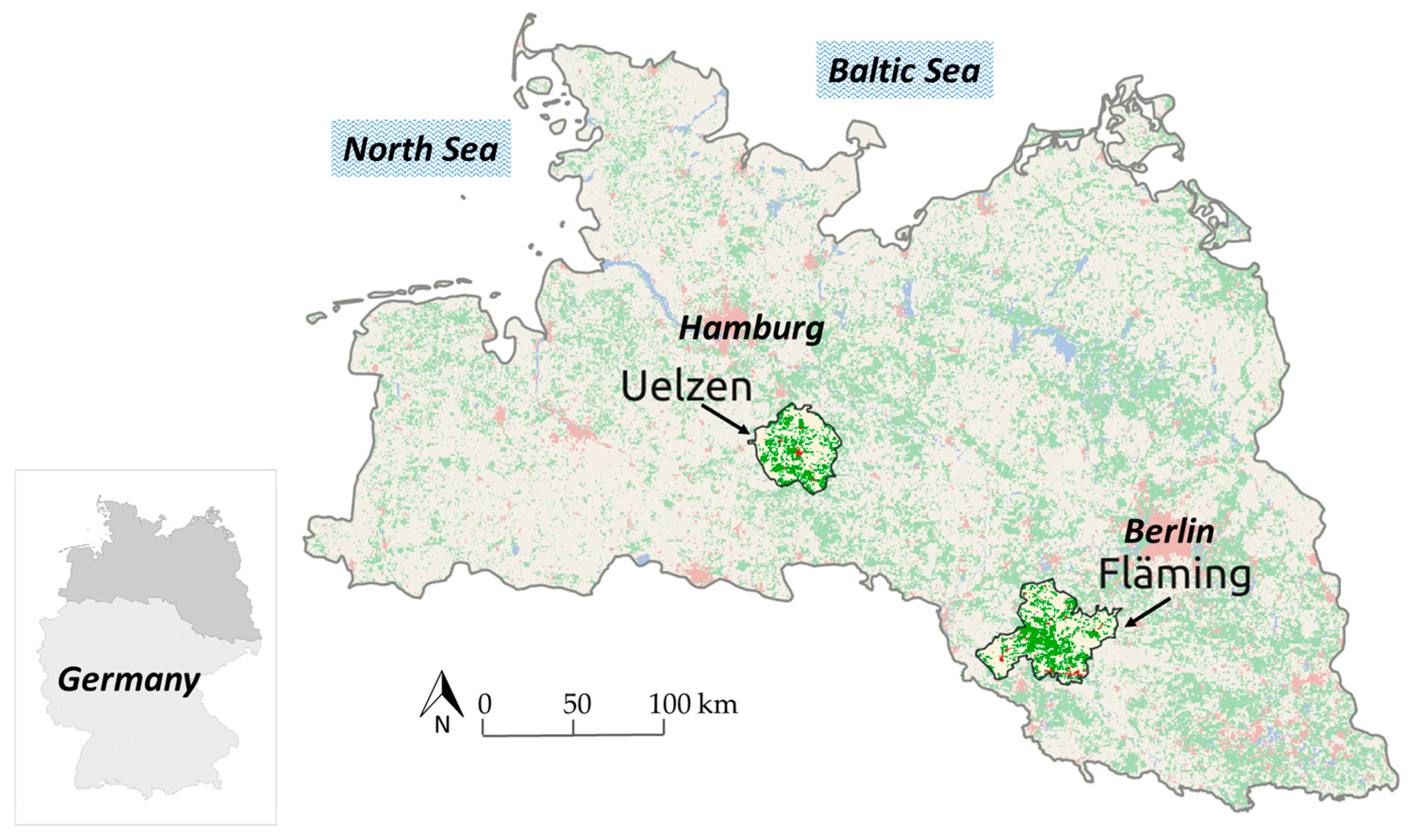
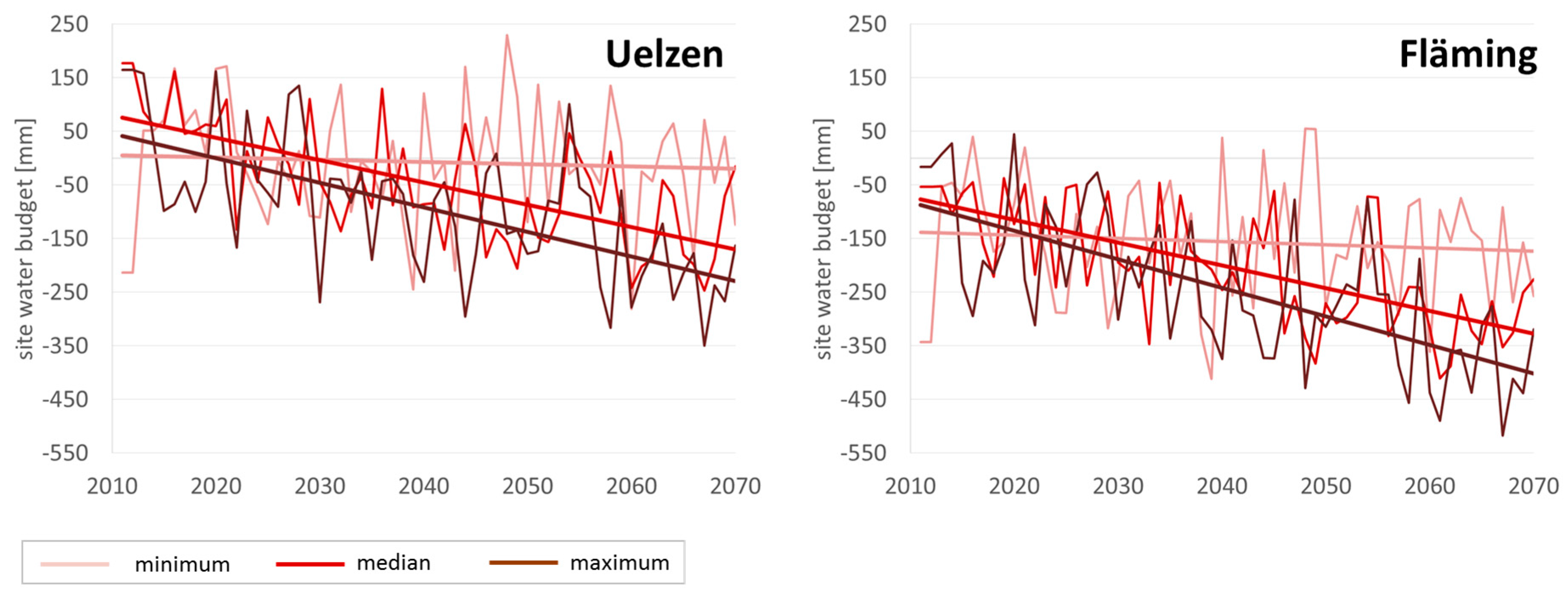
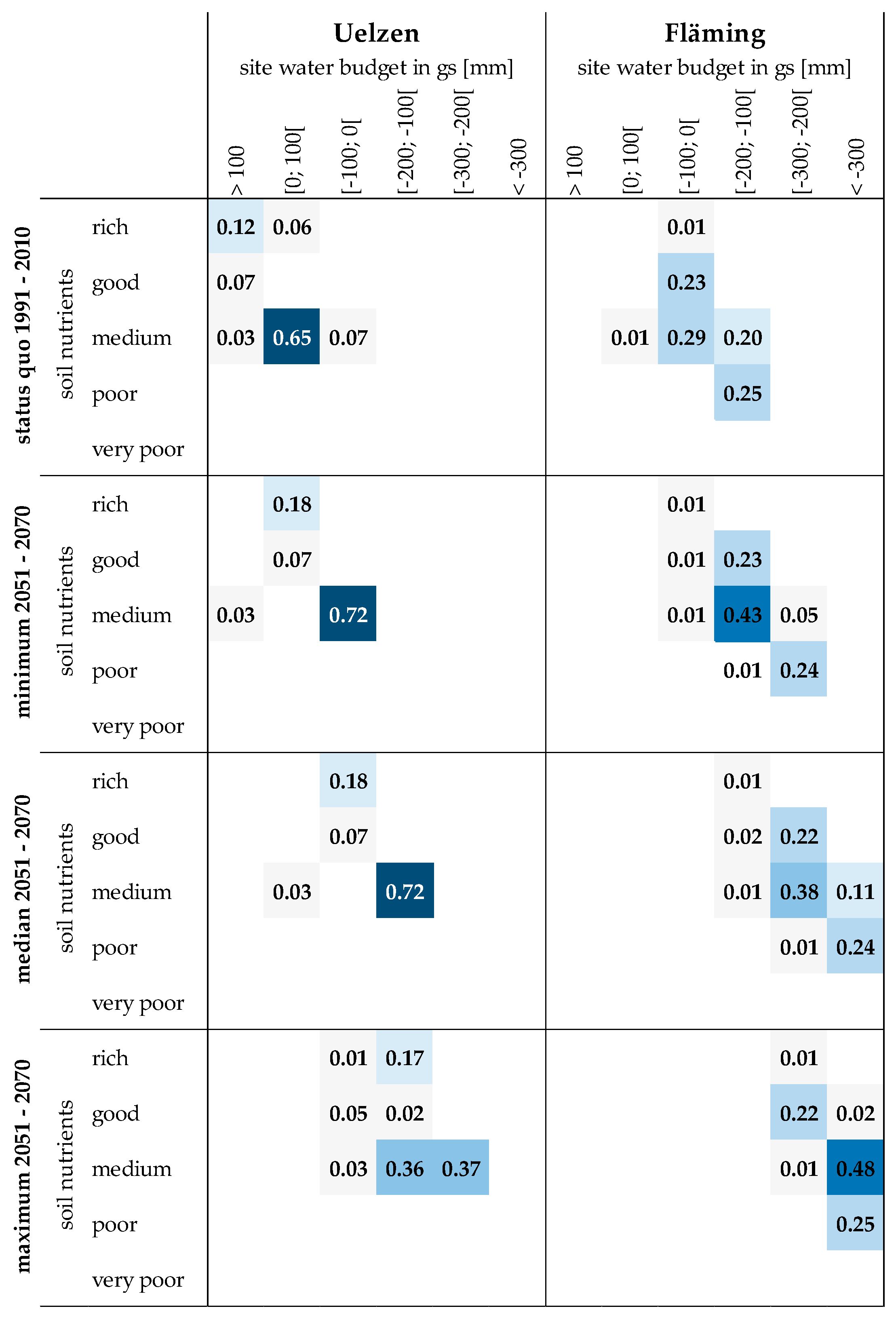

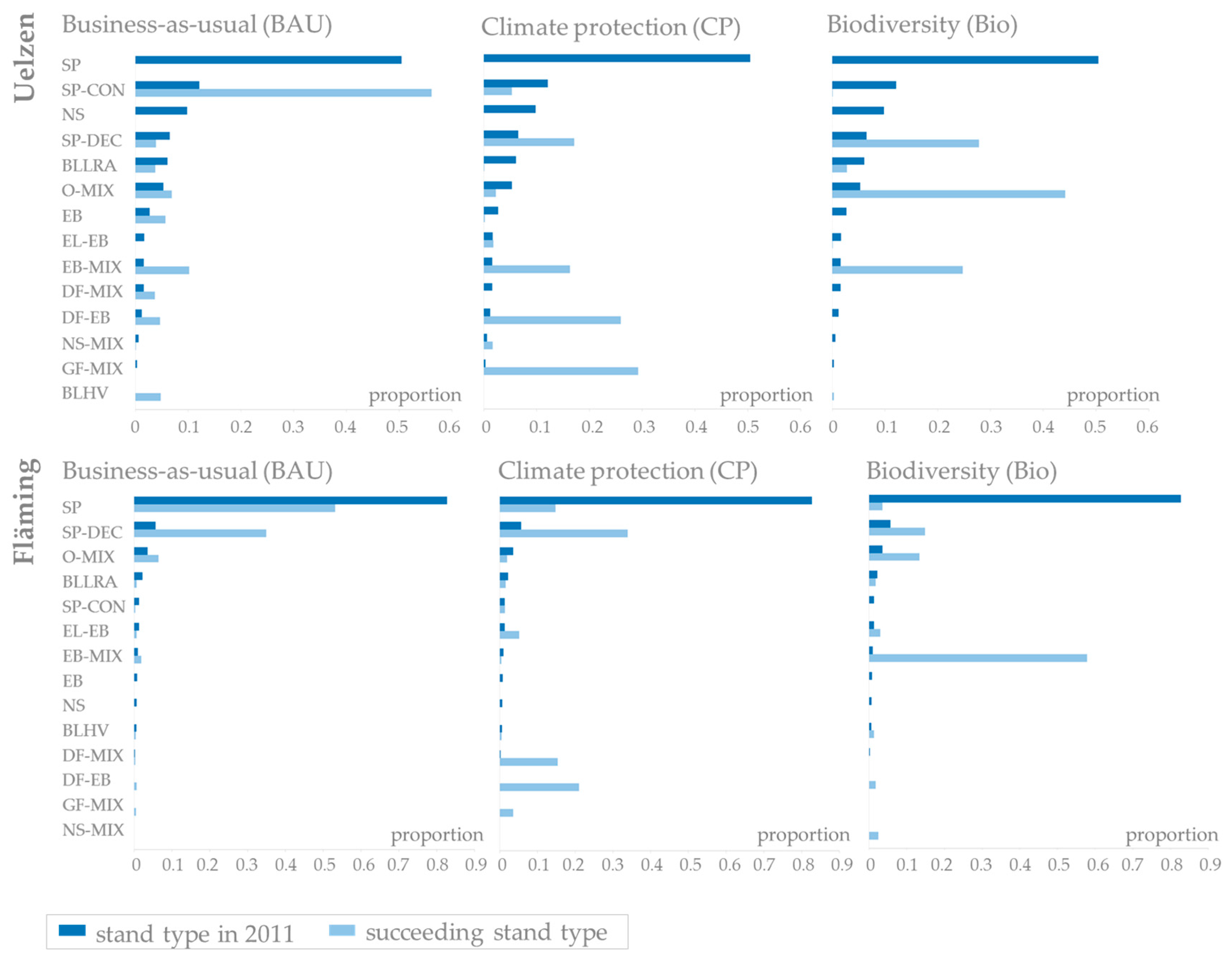
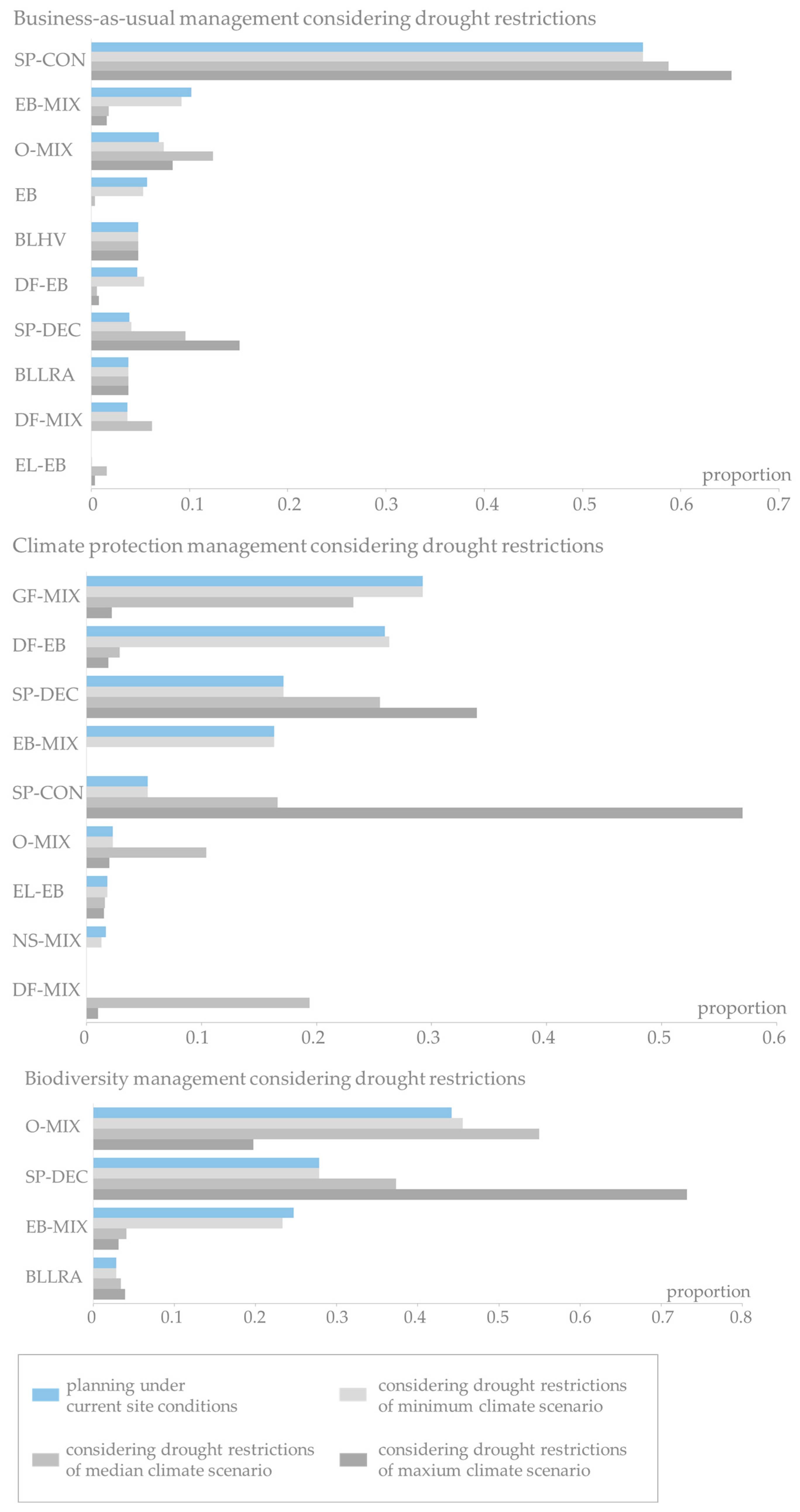
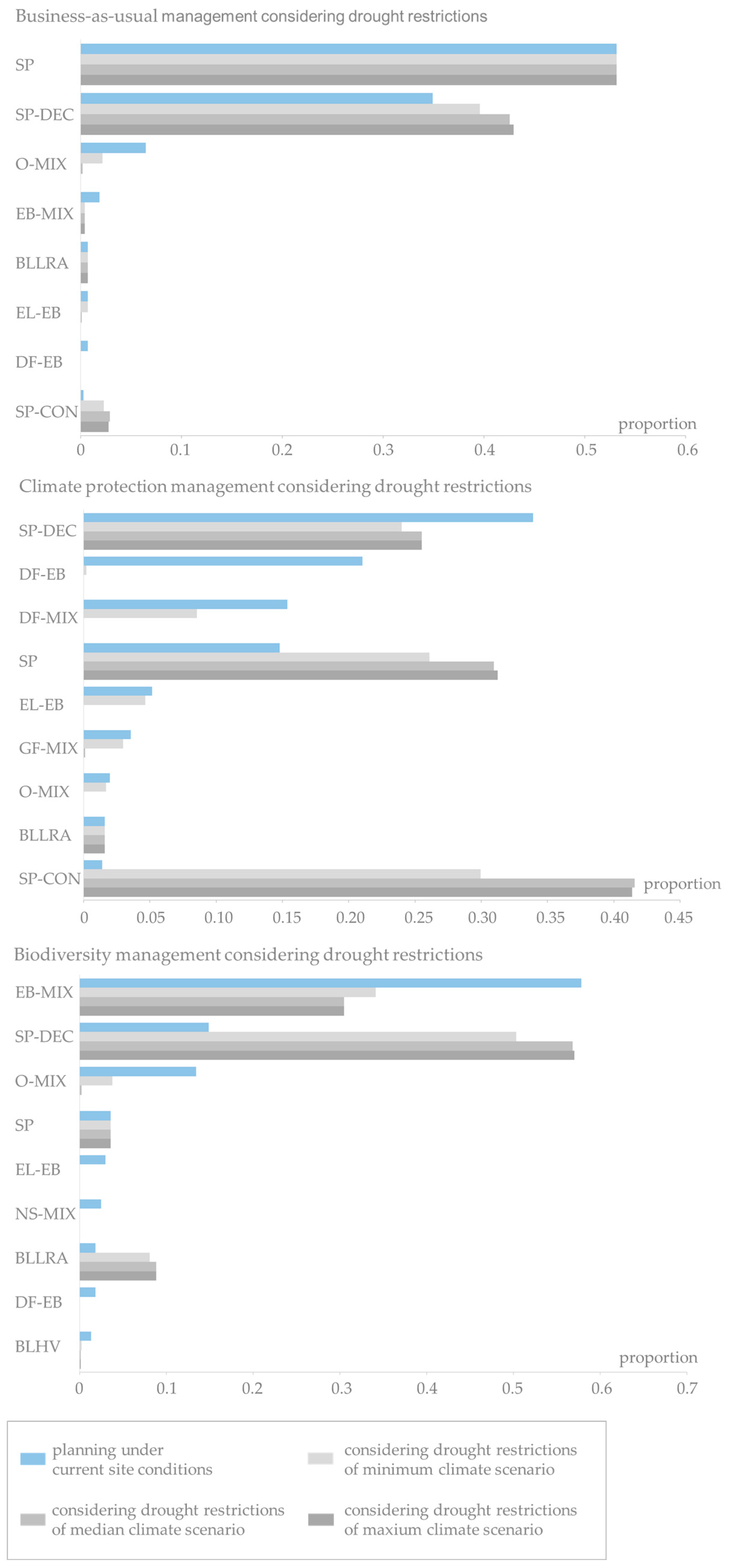
| European Beech | Oak | BLHV | BLLRA | Norway Spruce | Scots Pine | Douglas-Fir | European Larch | Grand Fir | |
|---|---|---|---|---|---|---|---|---|---|
| Uelzen | 4.8 | 6.1 | 0.7 | 8.0 | 13.3 | 61.3 | 3.9 | 1.9 | - |
| Fläming | 12.8 | 5.9 | 1.0 | 3.3 | 1.8 | 73.5 | 0.4 | 1.0 | 0.2 |
| Asm [mm] | Annual Temp. [°C] | Annual Prec. [mm] | cwbgs [mm] | |
|---|---|---|---|---|
| Uelzen | 110 | 9.2 | 727 | −65 |
| Fläming | 123 | 9.8 | 572 | −216 |
| Drought Vulnerability | Site Water Budget in Growing Season [mm] | Planning Measures | |||
|---|---|---|---|---|---|
| Norway Spruce | European Beech | Oak/Douglas-Fir | Scots Pine | ||
| low | >0 | >−25 | >−150 | >−180 | primary species |
| medium | 0 to −80 | −25 to −100 | −150 to −400 | −180 to −450 | admixture |
| high | <−80 | <−100 | <−400 | <−450 | no cultivation |
| SP | Scots pine (Pinus sylvestris L.) |
| SP-CON | Scots pine-conifer mixture |
| SP-DEC | Scots pine-deciduous species mixture |
| NS | Norway spruce (Picea abies L.) |
| NS-MIX | Norway spruce mixture |
| DF-MIX | Douglas-fir (Pseudotsuga menziesii (Mirb.) Franco)-mixture |
| DF-EB | Douglas-fir-European beech mixture |
| GF-MIX | Grand fir (Abies grandis (Douglas ex D. Don) Lindl.)-Douglas-fir mixture |
| EB | European beech (Fagus sylvatica) |
| EL-EB | European larch (Larix decidua Mill.)-European beech mixture |
| EB-MIX | European beech mixture |
| BLLRA | broadleaves of low rotation age |
| BLHV | broadleaves of high value |
| O-MIX | oak (Quercus petraea (Matt.) Liebl. and Quercus robur L.)-mixture |
| Climate Scenario | Uncertainty | ||||
|---|---|---|---|---|---|
| Minimum | Median | Maximum | Range | ||
| Uelzen | BAU | 2.0 | 17.9 | 21.8 | 19.8 |
| CP | 0.3 | 31.5 | 54.8 | 54.5 | |
| BIO | 3.2 | 48.5 | 74.1 | 70.9 | |
| Fläming | BAU | 12.2 | 14.9 | 15.1 | 2.9 |
| CP | 28.2 | 40.4 | 40.6 | 12.4 | |
| BIO | 50.5 | 56.1 | 56.2 | 5.7 | |
© 2017 by the authors. Licensee MDPI, Basel, Switzerland. This article is an open access article distributed under the terms and conditions of the Creative Commons Attribution (CC BY) license (http://creativecommons.org/licenses/by/4.0/).
Share and Cite
Albert, M.; Nagel, R.-V.; Nuske, R.S.; Sutmöller, J.; Spellmann, H. Tree Species Selection in the Face of Drought Risk—Uncertainty in Forest Planning. Forests 2017, 8, 363. https://doi.org/10.3390/f8100363
Albert M, Nagel R-V, Nuske RS, Sutmöller J, Spellmann H. Tree Species Selection in the Face of Drought Risk—Uncertainty in Forest Planning. Forests. 2017; 8(10):363. https://doi.org/10.3390/f8100363
Chicago/Turabian StyleAlbert, Matthias, Ralf-Volker Nagel, Robert S. Nuske, Johannes Sutmöller, and Hermann Spellmann. 2017. "Tree Species Selection in the Face of Drought Risk—Uncertainty in Forest Planning" Forests 8, no. 10: 363. https://doi.org/10.3390/f8100363





